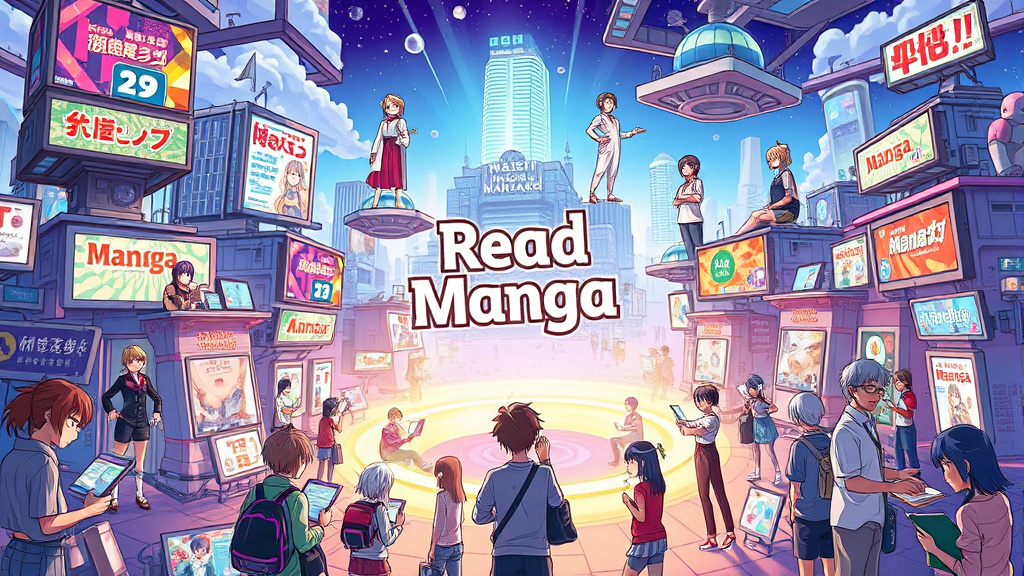manga only. These two words encapsulate a vast, dynamic universe of storytelling, art, and cultural expression that has captivated audiences worldwide. From humble comic strips in early Japan to global phenomena, manga continues to evolve, shape, and inspire millions. This article takes a comprehensive journey through the origins, genres, artistic styles, industry dynamics, and cultural impacts of manga, offering readers a deep understanding of why manga only is a unique and compelling art form that resonates beyond borders.
A Deep Dive into the World of Manga - Origins, History, and Cultural Impact
Manga only emerged from a rich cultural tapestry rooted in traditional Japanese art forms, such as ukiyo-e woodblock prints and emakimono (painted handscrolls), which date back centuries. Its modern form, however, began gaining popularity in the late 19th and early 20th centuries, influenced by Western comics and graphic narratives but molded by Japanese societal themes and artistic sensibilities. The post-World War II era marked a pivotal moment for manga, with artists like Osamu Tezuka pioneering storytelling techniques that would shape the industry into a powerful cultural force. Today, manga serves not only as entertainment but also as a mirror reflecting Japanese societal values, conflicts, and aspirations.
The cultural impact of manga is profound and far-reaching. It has influenced fashion, language, and art, while also providing a platform for discussing social issues, mental health, and identity. Importantly, manga's global reach has created cultural bridges, introducing Japanese storytelling techniques and aesthetics to diverse audiences worldwide. This cultural integration underscores manga only’s role as a unique vehicle of Japanese cultural diplomacy and soft power, making it an essential part of global pop culture.
 Hình minh họa: manga only – manga novels to read
Hình minh họa: manga only – manga novels to readExploring Diverse Genres in Manga - From Shojo to Seinen and Beyond
The vast landscape of manga is categorized into numerous genres, each catering to specific audiences and narrative styles. Shojo manga, aimed primarily at young girls, is characterized by its focus on romance, emotional development, and character relationships, often infused with delicate art styles. Conversely, seinen manga targets adult men with mature themes like politics, philosophy, or psychological depth, often featuring complex storylines and darker visuals. The diversity extends further with genres like shonen, for young boys thrilling in action and adventure; josei, for adult women with realistic and mature themes; and niche categories such as sports, horror, and science fiction—all showcasing manga's adaptability and breadth.
What makes this genre diversity so compelling is how each category reflects societal values and personal experiences. For example, shojo manga often explores themes of growth and self-discovery, resonating with younger readers navigating identity and love, while seinen manga can challenge societal taboos, offering adult audiences a mirror to complex themes. This variety ensures that manga only can speak to a broad spectrum of human emotions and circumstances, cementing its position as a versatile and inclusive medium.

The Art of Manga - Unique Visual Styles and Storytelling Techniques
Manga's visual distinctiveness stems from its unique artistic styles—ranging from minimalist and expressive lines to highly detailed and dynamic compositions. Artists employ innovative techniques like screentones to create texture, mood, and atmosphere, and paneling styles that control pacing and tension. The use of exaggerated facial expressions, speed lines, and symbolic imagery enhances storytelling, allowing emotions to leap from the page in vivid ways. These visual strategies are not just aesthetic choices but essential tools that deepen narrative impact and reader engagement.
Beyond aesthetics, manga storytelling employs advanced techniques such as split panels, symbolic motifs, and silent sequences to convey complex emotions, themes, and character development. This blend of art and narrative innovation encourages readers to interpret and feel the story viscerally, fostering a personal connection. The art of manga, therefore, is not merely illustration but a language of its own—creating a visceral storytelling experience that is both intimate and universally accessible.
The Manga Industry - Trends, Challenges, and the Rise of Digital Platforms
The manga industry is a multifaceted ecosystem, constantly adapting to technological advancements and consumer preferences. Historically dominated by print publications, the industry has faced challenges like piracy, declining print sales, and an aging readership. Yet, the rise of digital platforms such as Manga Plus, Crunchyroll, and ComiXology has revolutionized how manga is distributed, making it more accessible and affordable globally. These platforms facilitate rapid release schedules, multi-language translations, and interactive features, expanding manga's reach exponentially.
Industry trends also reflect shifting consumer habits—subscription models, web manga, and crowdfunding initiatives are reshaping the traditional landscape. Additionally, manga publishers are increasingly investing in diverse genres and stories to attract new demographics, promoting inclusivity and modern themes. The industry's resilience lies in its ability to innovate digitally while maintaining the artistic integrity and storytelling quality that have made manga only a beloved cultural phenomenon. Balancing tradition with innovation is key to its continued growth and relevance.
Iconic Manga Series That Shaped the Genre - A Retrospective Look
Throughout history, certain manga series have left indelible marks on the landscape of manga, influencing generations of artists and readers. Osamu Tezuka’s Astro Boy and Black Jack pioneered storytelling techniques that laid the foundation for modern manga. Later, series like Dragon Ball by Akira Toriyama revolutionized shonen manga with its dynamic action sequences and memorable characters, sparking a worldwide anime and manga boom. Similarly, Naruto and One Piece have become cultural icons, blending intricate world-building with emotional storytelling.
What makes these series iconic is their ability to resonate emotionally and culturally across different generations and epochs. They often set the tone for subsequent works and serve as benchmarks for quality and creativity in manga. These series exemplify manga only’s potential to create complex worlds and characters that invite fandoms, inspire adaptations, and influence global pop culture. Their legacies are testament to the genre’s capacity for storytelling excellence and enduring appeal.
Influential Manga Artists - Masters of the Craft and Their Legacy
The craft of manga is driven by visionary artists whose innovative styles and storytelling have revolutionized the medium. Osamu Tezuka, often called the "God of Manga," was a pioneer whose work laid the groundwork for character design and narrative depth. Katsuhiro Otomo’s Akira pushed the boundaries of artistic complexity and cyberpunk storytelling, inspiring countless artists and creators worldwide. Rumiko Takahashi’s romantic comedies and Hirohiko Araki’s JoJo’s Bizarre Adventure exemplify how personal style can evolve into a signature, influencing popular trends.
The legacies of these masters extend beyond their individual works—they have mentored new generations of artists and helped define manga’s artistic standards. Their ability to combine storytelling mastery with visual innovation has enriched the genre’s richness and diversity. These artists exemplify manga only as an art form that is continuously evolving, driven by creative mastery and a passion for push boundaries in storytelling and visual aesthetics.
Translating Manga - Cultural Nuances and the Challenges of Localization
Translating manga involves much more than converting text from one language to another; it requires capturing cultural nuances, idiomatic expressions, and societal context. Localization teams aim to preserve the original tone, humor, and cultural references while making it accessible to a new audience. This delicate balancing act often involves difficult choices—whether to adapt culturally specific jokes or maintain authenticity, and how to handle sensitive material without losing meaning.
One of the greatest challenges is maintaining the emotional impact of visual storytelling that relies heavily on subtle cultural cues. For instance, certain symbols or gestures might carry specific meanings in Japanese culture but need contextual explanation or adaptation for international readers. Successful localization respects the original work while bridging cultural gaps, allowing manga only to truly engage global audiences. It’s a creative process that demonstrates the universality of storytelling, even when navigating cultural differences.
Manga and Anime - The Symbiotic Relationship and Adaptation Process
Manga and anime have a close, mutually enriching relationship—each feeds into the other’s popularity and artistic development. Many manga series serve as a blueprint for anime adaptations, which often boost sales of the original manga. Conversely, adventures and visual storytelling techniques pioneered in anime influence new manga styles and narrative approaches. This synergy accelerates the growth of both media and expands the reach of manga only as a cultural product.
The adaptation process often involves creative reinterpretation, whether through animation, voice acting, or character design, which adds new layers to the original story. However, challenges such as pacing issues, censorship, or divergence from the source material can impact fan reception. Despite this, the symbiosis between manga and anime continues to be central to their global appeal, expanding audiences and deepening the cultural resonance of manga only as a dynamic, cross-media experience.
The Global Appeal of Manga - Why It Resonates with Readers Worldwide
Manga’s global success can be attributed to its ability to tell universally relatable stories while embracing deep cultural specificities. Its visual storytelling makes it accessible even for non-native speakers, transcending language barriers through expressive art. The diverse genres and themes cater to varied tastes worldwide, from the escapism of fantasy to the introspection of slice-of-life stories. Moreover, dedicated fandoms, conventions, and online communities foster a sense of belonging, fueling its international popularity.
What makes manga resonate across borders is its ability to evoke emotions, challenge cultural assumptions, and present inspiring narratives. It invites global readers into a uniquely Japanese perspective while allowing them to see shared human experiences. Its adaptability and openness to diverse storytelling styles ensure that manga only remains a vibrant and significant part of global pop culture, uniting people through the power of visual story art.
Collecting Manga - Tips for Building a Comprehensive and Valuable Collection
Building a manga collection is a journey that combines passion, strategy, and knowledge. Start by focusing on series and genres that resonate most with your interests, then consider factors like editions, print quality, and rarity for value appreciation. Preservation is crucial—storing manga in a cool, dry place and avoiding direct sunlight prevents deterioration. For collectors seeking value, condition and completeness are vital, so invest in well-preserved hardcover editions or first prints whenever possible.
Beyond the technical aspects, collecting manga is also about appreciating its artistic and cultural significance. Engage with community forums, attend conventions, and stay informed about limited editions or signed copies. The value of a collection grows not only through its monetary worth but also through personal connection and historical significance. Making informed choices ensures that your manga collection remains both a cherished hobby and a valuable cultural archive over time.
Conclusion
Manga only stands as a testament to the power of visual storytelling, cultural expression, and artistic innovation. Its origins rooted in traditional Japanese art evolved into a global phenomenon that resonates with diverse audiences through countless genres, iconic series, and talented creators. The dynamic industry adapts through technological advances while maintaining its artistic integrity, and the close relationship between manga and anime continues to expand its influence worldwide. Whether as a form of entertainment, cultural dialogue, or collectible treasure, manga only remains at the forefront of a vibrant artistic landscape that unites people across generations and borders, exemplifying the enduring power of visual narrative.





